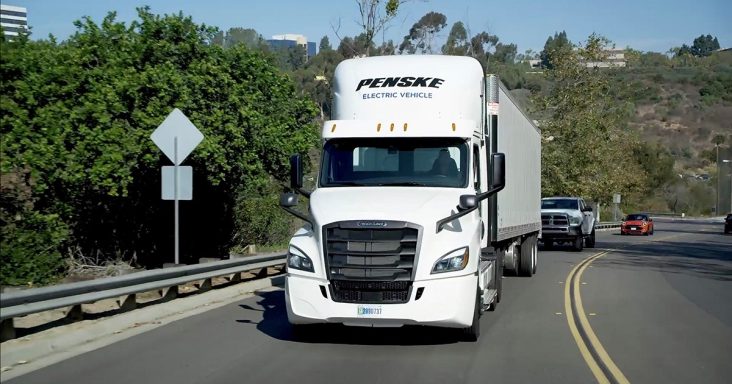Heavy-duty electric vehicle reports show mixed projections for emissions reductions
by June 6, 2022 2:17 pm 1,329 views

Existing heavy-duty electric vehicles can be used to complete about half of regional hauls, especially for routes of no more than 100 miles, a recent report shows. Still, the emissions reductions attributed to electric vehicles don’t look to be as significant when considering the full vehicle life cycle.
According to the report by North American Council for Freight Efficiency (NACFE), existing technology is not available to replace every heavy-duty diesel truck with battery electric vehicles, but it is available for vehicles on regional routes of less than 200 miles per day, including those hauling heavy loads.
However, even with compliance with one of the strictest electrification regulations in the United States, the Advanced Clean Trucks (ACT) regulation in California, this likely won’t be enough to offset the projected rise in emissions based on the expected increase in freight demand in the coming decades, according to a report by RMI. Truck emissions have nearly doubled over the past 30 years and have continued to increase as the industry expands to accommodate a growing economy and a rise in e-commerce.
“Electrification remains critical to ensure that carbon emissions from freight do not continue to increase over the next 15 years,” according to RMI. “Electrification is possible, but fleets will need support from a large group of players, and utilities will need to ensure that electric truck charging can occur at a reasonable price.”
The NACFE report shows 937,563 regional haul class 8 trucks, the largest truck class, are operating in the United States and Canada. If half were electric vehicles, this would result in the avoidance of nearly 29.4 million metric tons of carbon dioxide equivalent, according to the report.
“Heavy-duty regional haul tractors drive three to 10 times more miles than their medium-duty brethren, offering a huge decarbonization opportunity,” said Mike Roeth, executive director for NACFE. “Their return to base operation also provides confidence for investing in infrastructure.”
A class 8 battery electric vehicle provides savings of $9,300 in fuel costs per year, compared to a class 8 diesel truck, the report shows. The savings were based on 2021 data when diesel prices were $3.28 per gallon. According to AAA, the national average for diesel is $5.64 a gallon, up 72% from the 2021 average.
According to NACFE, the list price for a battery electric vehicle is about two or three times that of a comparable diesel truck. But credits, grants and other incentives can offset the higher cost. And, the total cost of ownership over five years “will show the (battery electric vehicle) is better,” the report shows.
Along with the higher upfront cost, other challenges for electric vehicle investment include battery charging time and a lack of available chargers for heavy-duty vehicles. Also, installation for the chargers might take months to years. Another concern regards the life span of batteries.
According to a new report by American Transportation Research Institute (ATRI), the production of lithium-ion batteries generates more than six times the carbon of diesel truck production. The report includes the full vehicle life-cycle in how it compares emissions reductions between diesel and electric vehicles.
ATRI’s analysis shows that full life-cycle carbon dioxide emissions for the battery electric truck would be 30% less than a diesel truck. Some of the factors for the marginal emissions reduction include the emissions related to battery production and that the U.S. electrical grid largely relies on fossil fuels. The research incorporated the carbon dioxide emissions attributed to the grid.
According to ATRI, hydrogen fuel cell trucks are the most environmentally-friendly truck type. The technology is not yet feasible for long-haul operations.
“The U.S. trucking industry is strongly committed to carbon-reduction efforts, and electric motors and drive trains offer many additional performance and maintenance benefits,” said Hugh Ekberg, president and CEO of CRST. “But ATRI’s research highlights that several of the leading zero-emission approaches being advocated today still need additional research to fully understand how the different technologies can be best developed and utilized to maximize carbon reduction.”
The ARTI report also showed that existing diesel trucks that use renewable diesel could decrease carbon dioxide emissions to 32.7% of a standard diesel engine. And, hydrogen sourced from solar-power electricity could enable hydrogen fuel cell trucks to emit 8.8% of the diesel emissions.
